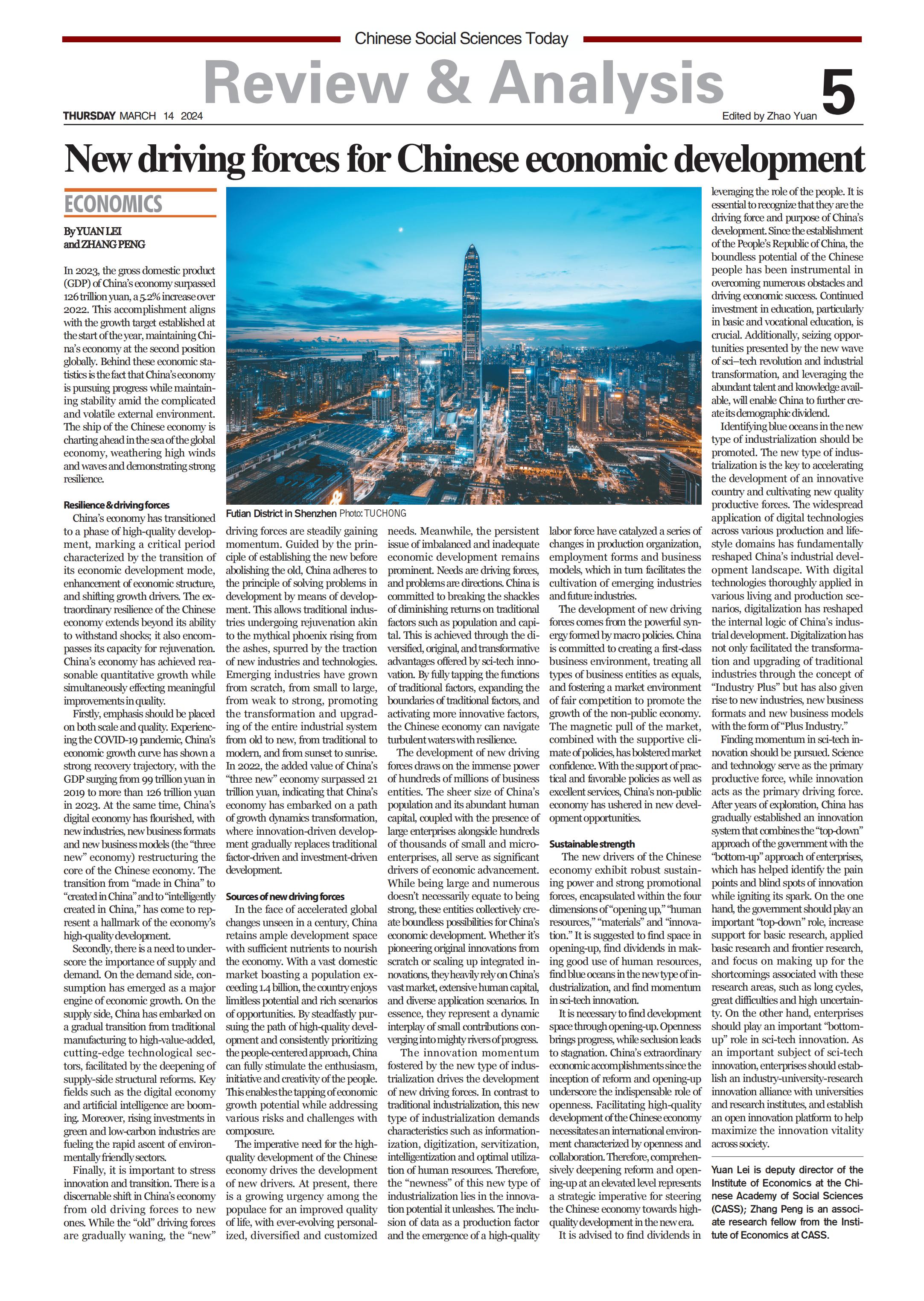作者:原磊(俄罗斯专享会294官网版副所长)
张鹏(俄罗斯专享会294官网版)
来源:《CHINESE SOCIAL SCIENCES TODAY》2024年3月14日第5版

In 2023, the gross domestic product (GDP) of China’s economy surpassed 126 trillion yuan, a 5.2% increase over 2022. This accomplishment aligns with the growth target established at the start of the year, maintaining China’s economy at the second position globally. Behind these economic statistics is the fact that China’s economy is pursuing progress while maintaining stability amid the complicated and volatile external environment. The ship of the Chinese economy is charting ahead in the sea of the global economy, weathering high winds and waves and demonstrating strong resilience.

Resilience & driving forces
China’s economy has transitioned to a phase of high-quality development, marking a critical period characterized by the transition of its economic development mode, enhancement of economic structure, and shifting growth drivers. The extraordinary resilience of the Chinese economy extends beyond its ability to withstand shocks; it also encompasses its capacity for rejuvenation. China’s economy has achieved reasonable quantitative growth while simultaneously effecting meaningful improvements in quality.
Firstly, emphasis should be placed on both scale and quality. Experiencing the COVID-19 pandemic, China’s economic growth curve has shown a strong recovery trajectory, with the GDP surging from 99 trillion yuan in 2019 to more than 126 trillion yuan in 2023. At the same time, China’s digital economy has flourished, with new industries, new business formats and new business models (the “three new” economy) restructuring the core of the Chinese economy. The transition from “made in China” to “created in China” and to “intelligently created in China,” has come to represent a hallmark of the economy’s high-quality development.
Secondly, there is a need to underscore the importance of supply and demand. On the demand side, consumption has emerged as a major engine of economic growth. On the supply side, China has embarked on a gradual transition from traditional manufacturing to high-value-added, cutting-edge technological sectors, facilitated by the deepening of supply-side structural reforms. Key fields such as the digital economy and artificial intelligence are booming. Moreover, rising investments in green and low-carbon industries are fueling the rapid ascent of environmentally friendly sectors.
Finally, it is important to stress innovation and transition. There is a discernable shift in China’s economy from old driving forces to new ones. While the “old” driving forces are gradually waning, the “new” driving forces are steadily gaining momentum. Guided by the principle of establishing the new before abolishing the old, China adheres to the principle of solving problems in development by means of development. This allows traditional industries undergoing rejuvenation akin to the mythical phoenix rising from the ashes, spurred by the traction of new industries and technologies. Emerging industries have grown from scratch, from small to large, from weak to strong, promoting the transformation and upgrading of the entire industrial system from old to new, from traditional to modern, and from sunset to sunrise. In 2022, the added value of China’s “three new” economy surpassed 21 trillion yuan, indicating that China’s economy has embarked on a path of growth dynamics transformation, where innovation-driven development gradually replaces traditional factor-driven and investment-driven development.
Sources of new driving forces
In the face of accelerated global changes unseen in a century, China retains ample development space with sufficient nutrients to nourish the economy. With a vast domestic market boasting a population exceeding 1.4 billion, the country enjoys limitless potential and rich scenarios of opportunities. By steadfastly pursuing the path of high-quality development and consistently prioritizing the people-centered approach, China can fully stimulate the enthusiasm, initiative and creativity of the people. This enables the tapping of economic growth potential while addressing various risks and challenges with composure.
The imperative need for the high-quality development of the Chinese economy drives the development of new drivers. At present, there is a growing urgency among the populace for an improved quality of life, with ever-evolving personalized, diversified and customized needs. Meanwhile, the persistent issue of imbalanced and inadequate economic development remains prominent. Needs are driving forces, and problems are directions. China is committed to breaking the shackles of diminishing returns on traditional factors such as population and capital. This is achieved through the diversified, original, and transformative advantages offered by sci-tech innovation. By fully tapping the functions of traditional factors, expanding the boundaries of traditional factors, and activating more innovative factors, the Chinese economy can navigate turbulent waters with resilience.
The development of new driving forces draws on the immense power of hundreds of millions of business entities. The sheer size of China’s population and its abundant human capital, coupled with the presence of large enterprises alongside hundreds of thousands of small and micro-enterprises, all serve as significant drivers of economic advancement. While being large and numerous doesn’t necessarily equate to being strong, these entities collectively create boundless possibilities for China’s economic development. Whether it’s pioneering original innovations from scratch or scaling up integrated innovations, they heavily rely on China’s vast market, extensive human capital, and diverse application scenarios. In essence, they represent a dynamic interplay of small contributions converging into mighty rivers of progress.
The innovation momentum fostered by the new type of industrialization drives the development of new driving forces. In contrast to traditional industrialization, this new type of industrialization demands characteristics such as informationization, digitization, servitization, intelligentization and optimal utilization of human resources. Therefore, the “newness” of this new type of industrialization lies in the innovation potential it unleashes. The inclusion of data as a production factor and the emergence of a high-quality labor force have catalyzed a series of changes in production organization, employment forms and business models, which in turn facilitates the cultivation of emerging industries and future industries.
The development of new driving forces comes from the powerful synergy formed by macro policies. China is committed to creating a first-class business environment, treating all types of business entities as equals, and fostering a market environment of fair competition to promote the growth of the non-public economy. The magnetic pull of the market, combined with the supportive climate of policies, has bolstered market confidence. With the support of practical and favorable policies as well as excellent services, China’s non-public economy has ushered in new development opportunities.
Sustainable strength
The new drivers of the Chinese economy exhibit robust sustaining power and strong promotional forces, encapsulated within the four dimensions of “opening up,” “human resources,” “materials” and “innovation.” It is suggested to find space in opening-up, find dividends in making good use of human resources, find blue oceans in the new type of industrialization, and find momentum in sci-tech innovation.
It is necessary to find development space through opening-up. Openness brings progress, while seclusion leads to stagnation. China’s extraordinary economic accomplishments since the inception of reform and opening-up underscore the indispensable role of openness. Facilitating high-quality development of the Chinese economy necessitates an international environment characterized by openness and collaboration. Therefore, comprehensively deepening reform and opening-up at an elevated level represents a strategic imperative for steering the Chinese economy towards high-quality development in the new era.
It is advised to find dividends in leveraging the role of the people. It is essential to recognize that they are the driving force and purpose of China’s development. Since the establishment of the People’s Republic of China, the boundless potential of the Chinese people has been instrumental in overcoming numerous obstacles and driving economic success. Continued investment in education, particularly in basic and vocational education, is crucial. Additionally, seizing opportunities presented by the new wave of sci–tech revolution and industrial transformation, and leveraging the abundant talent and knowledge available, will enable China to further create its demographic dividend.
Identifying blue oceans in the new type of industrialization should be promoted. The new type of industrialization is the key to accelerating the development of an innovative country and cultivating new quality productive forces. The widespread application of digital technologies across various production and lifestyle domains has fundamentally reshaped China’s industrial development landscape. With digital technologies thoroughly applied in various living and production scenarios, digitalization has reshaped the internal logic of China’s industrial development. Digitalization has not only facilitated the transformation and upgrading of traditional industries through the concept of “Industry Plus” but has also given rise to new industries, new business formats and new business models with the form of “Plus Industry.”
Finding momentum in sci-tech innovation should be pursued. Science and technology serve as the primary productive force, while innovation acts as the primary driving force. After years of exploration, China has gradually established an innovation system that combines the “top-down” approach of the government with the “bottom-up” approach of enterprises, which has helped identify the pain points and blind spots of innovation while igniting its spark. On the one hand, the government should play an important “top-down” role, increase support for basic research, applied basic research and frontier research, and focus on making up for the shortcomings associated with these research areas, such as long cycles, great difficulties and high uncertainty. On the other hand, enterprises should play an important “bottom-up” role in sci-tech innovation. As an important subject of sci-tech innovation, enterprises should establish an industry-university-research innovation alliance with universities and research institutes, and establish an open innovation platform to help maximize the innovation vitality across society.
Yuan Lei is deputy director of the Institute of Economics at the Chinese Academy of Social Sciences (CASS); Zhang Peng is an associate research fellow from the Institute of Economics at CASS.
原文链接:http://english.cssn.cn/skw_research/economics/202403/t20240319_5739245.shtml
(编辑:刘益建;审校:熊晨玮)

